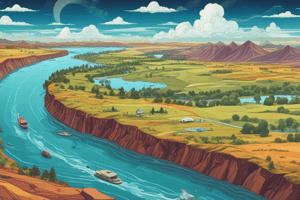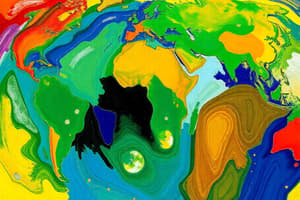Podcast
Questions and Answers
What is the primary function of the Earth's atmosphere?
What is the primary function of the Earth's atmosphere?
- To protect the planet from solar radiation and cosmic particles (correct)
- To regulate the planet's temperature
- To create the planet's geographical features
- To provide a habitat for living organisms
What is the most relevant layer of the Earth's atmosphere to human life?
What is the most relevant layer of the Earth's atmosphere to human life?
- Exosphere
- Stratosphere
- Troposphere (correct)
- Mesosphere
What is the main characteristic of tropical rainforests?
What is the main characteristic of tropical rainforests?
- Low rainfall and abundant animal life
- High temperatures and low rainfall
- High rainfall and abundant plant life (correct)
- High temperatures and low plant life
What is the primary focus of human geography?
What is the primary focus of human geography?
Why is understanding Earth's geological history important?
Why is understanding Earth's geological history important?
What is the position of Earth in the solar system?
What is the position of Earth in the solar system?
What makes Earth's geography a rich tapestry of landscapes?
What makes Earth's geography a rich tapestry of landscapes?
What is the main factor in the formation of mountains like the Himalayas and Andes?
What is the main factor in the formation of mountains like the Himalayas and Andes?
What type of landform are the Tibetan Plateau and other similar regions?
What type of landform are the Tibetan Plateau and other similar regions?
What is the unique feature of Earth's coastlines?
What is the unique feature of Earth's coastlines?
Flashcards are hidden until you start studying
Study Notes
Earth as a Planet: An In-Depth Geographical Exploration
Earth is the third planet from the Sun and the fifth largest of the eight planets in the solar system. It is a unique planet in many ways, with a diverse range of physical and environmental features that make it the only known planet to support life. Earth's geography is a rich tapestry of landscapes, from towering mountains and vast deserts to lush forests and expansive oceans.
Earth's Physical Geography
Earth's physical geography encompasses a variety of features that are essential for the planet's life-supporting environment. The planet's surface is divided into several major landforms, including mountains, plateaus, hills, plains, and basins. Mountains, such as the Himalayas and Andes, are formed by tectonic activity and contribute significantly to Earth's diverse topography. Plateaus, like the Tibetan Plateau, are large, elevated regions that offer unique ecosystems and geological features. Hills and plains are more gently sloping landforms, while basins are areas of low elevation that often contain bodies of water, such as lakes and seas.
The planet's coastlines are another important aspect of its physical geography. They are shaped by geological processes, such as erosion and tectonic activity, and are home to a variety of ecosystems, including beaches, wetlands, and estuaries. Earth's coastlines are also where the land and sea meet, creating a unique interface that supports a wide range of plant and animal species.
Earth's Environmental Features
Earth's environmental features are closely tied to its physical geography, with various ecosystems and habitats that support a diverse range of life. The planet's forests, grasslands, deserts, and oceans each have their unique characteristics and support a variety of plant and animal species. For instance, tropical rainforests are characterized by their high rainfall and abundant plant life, while deserts are known for their aridity and unique adaptations by plants and animals to survive in harsh conditions.
Earth's Atmosphere and Climate
Earth's atmosphere is a critical component of its geography, providing a protective shield from solar radiation and cosmic particles. It is composed of several layers, with the troposphere being the lowest and the most relevant to human life, as it is where all weather phenomena occur. Earth's climate is influenced by various factors, including its position in the solar system, atmospheric composition, and geographical features like mountains and oceans. The planet experiences a wide range of climates, from the cold polar regions to the hot, humid tropics.
Earth's Geological History
Earth's geological history is characterized by a series of geological periods that have shaped the planet's surface and environment. These periods are defined by the dominant geological processes and events that occurred during each time frame, such as plate tectonics, volcanic activity, and climate change. Understanding Earth's geological history is crucial for understanding the planet's current geography and its potential future changes.
Earth's Human Geography
Human geography examines the relationship between humans and their environment, focusing on the spatial distribution of human populations and their activities. This includes the study of global patterns of urbanization, population distribution, and economic activities. Human geography also explores the impact of human activities on the environment, such as deforestation, pollution, and climate change.
Earth's Geography and Other Academic Disciplines
Geography is interdisciplinary, meaning it can be connected to various other academic disciplines, such as chemistry, economics, and philosophy. For example, chemists study the distribution of chemical elements on Earth, while economists examine the spatial patterns of economic activities and trade. Philosophers often explore the relationship between humans and the natural environment, discussing topics such as environmental ethics and sustainability.
In conclusion, Earth's geography is a complex and multifaceted field that encompasses various physical, environmental, and human aspects. Understanding Earth's geography allows us to appreciate the planet's unique features, appreciate the diversity of life on Earth, and make informed decisions about our impact on the environment.
Studying That Suits You
Use AI to generate personalized quizzes and flashcards to suit your learning preferences.




